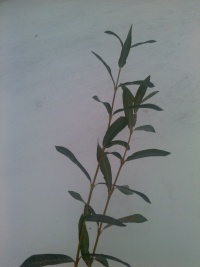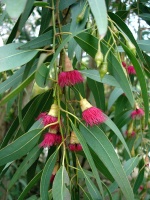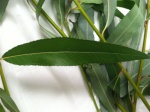Aravot
One of the four species mentioned in the Torah to be taken on Sukkot is ערבי נחל which are translated as the leafy branch of a specific type of willow tree. They are described by the torah as willows of the river because most of this species grows by the river.[1]
General Laws
- One should use two aravot branches for the mitzvah. Each aravah should be at least 3 Tefachim in length.[2]
Signs of a Kosher Aravah
- The leaves of the aravah should preferably be long and narrow with smooth edges. If the edges of the leaves have small serrations, the aravah is nonetheless valid. If, however, the stem is white, the leaves are rounded, or the edges of the leaves have large serrations, the aravah is invalid.[3]
- The stem should be green or red, but not white.[4]
- The aravot should have all 3 of the above mentioned signs (long leaves, smooth edges, and green or red stem) and not just one of them.[5]
- Although most aravot grow by the water, an aravah is valid no matter where it grew. Some say that it is preferable to use aravot that grew by a river, whereas others say that there is no such preference.[6]
- The Eucalyptus species which looks similar to the aravah is pasul. (See picture to the right).[7]
Aravot which lost leaves or dried out
- If most of the leaves of an aravah dried out to the extent that they lost their green color, the aravah is pasul. If, however, the leaves only withered and did not completely dry out, the aravah may still be used.[8]
- If a majority of the leaves fall off the aravah, it is invalid.[9]
- The aravah is invalidated if a majority of the leaves are removed.[10]
Related Pages
Sources
- ↑ The Pasuk in Vayikra 23:40 says one should take Arvei Nachal as part of the four species. The Rambam (Shofar VeSukkah 7:3) writes that since most of this species of willow grows by the river the Torah called it Arvei Nachal, a leafy tree that grows by the river.
- ↑ Rambam (7:7) and Shulchan Aruch (651:1) rule in accordance with Rabbi Yishmael, who requires three hadasim and two aravot. The Rama adds that in extenuating circumstances, one may use just one hadas. Regarding their sizes, Shulchan Aruch (650:1) rules like Tosfot that the minimum size for both hadasim and aravot is 10 etzba’ot; however, he also mentions the Rif’s opinion of 12 etzba’ot (see note 3).
- ↑
The Mishna (33b) writes that a tzaftzefa is not the same species as an aravah. The Gemara (34a) writes that an aravah has long and narrow leaves with smooth edges, whereas a tzaftzefa has round leaves with serrated, saw-like edges. Mishna Brurah 647:2 writes that if the aravah has any of the features of a tzaftzefa it is invalid. The Gemara then says that there is a certain aravah, the chilfa gila, that is valid even though the edges of its leaves are serrated. Rashi (s.v. Vehatanya) explains that if all of the serrations face inward, it is acceptable. The Rambam (7:4), however, explains that if the edges have small serrations, it is acceptable. The Tur (647:1) follows the explanation of Rashi, whereas Shulchan Aruch (647:1) follows that of the Rambam. Aruch HaShulchan (647:4) rules that one may follow either view. (The Kesef Mishna there points out this dispute between Rashi and the Rambam). The Tur 647:1 follows the explanation of Rashi, whereas Shulchan Aruch 647:1 follows the Rambam's. Chazon Ovadya (p. 316) follows the explanation of Shulchan Aruch.
- ↑ The Mishna (Sukkah 33b) writes that a safsafa is not Kosher in place of aravah. The gemara Sukkah 34a writes that the aravah's stem is supposed to be red as opposed to the safsafa (a pasul species similar to aravah) has a white stem. This sign is quoted by the Rif 16a, Rambam 7:3-4, and Rosh 3:13. Bet Yosef 647:1 writes that it's logical to say that even if the stem of the aravah is green it is kosher because only the side which was in the sun turns red, and it's only pasul if the stem is white. Rama 647:1 codifies this. Mishna Brurah 647:2 and Chazon Ovadyah (p. 316) concur.
- ↑ Pri Megadim M"Z 647:1 writes that the aravot need to have all 3 signs of a kosher aravah and one isn't enough. Mishna Brurah 647:2 also quotes the Bikkurei Yacov who says that it's not common to have one of the signs without the others. Chazon Ovadayah (p. 317) quotes the Sfat Emet (Sukkah 34a) who writes that only the signs of having long leaves and red stem are important to distinguish the aravah. Chazon Ovadyah (p. 316) quotes Sh"t Eretz Tova 24 who writes that an aravah which has all 3 signs is kosher even if the biologists say that it isn't the species as the other aravot.
- ↑ *The Gemara (33b) states that although the Torah says “arvei nachal,” meaning branches of a willow that grows by a river, Chazal explained that the pasuk also allows an aravah that did not grow near a river. Rashi (s.v. Arvei) writes that while an aravah that grew by the water is preferable, one nonetheless fulfills his obligation with an aravah that grew elsewhere. Rav Hershel Schachter (“The Halachos of the Daled Minim,” min 50) explained that having aravot that grew by a river is a hidur since it also fulfills the simple interpretation of the pasuk (a similar idea is expressed in the Ritva Yevamot 103b). Tosfot (34a s.v. Verabbanan) suggests that this Gemara follows Rabbi Akiva's opinion and the halacha does not follow Rabbi Akiva. Therefore, Tosfot recommends using aravot only if they grew by a river.
- The Rosh (3:13) writes that it seems that the Rif agrees with Tosfot, as he does not quote the Gemara on 33b. Nonetheless, the Rosh records that the minhag was to use aravot even if they did not grow by a river. To defend the minhag, the Rosh rejects the view of Tosfot, and instead argues that the Gemara was agreed upon by all opinions. The Tur (647) writes that although most authorities maintain that having an aravah that grew by the water is preferable, the Rosh and Rambam (7:3) seem to hold that aravah wherever it grew is totally acceptable.
- Shulchan Aruch (647:1) quotes the language of the Rambam in ruling that all aravot are acceptable for use. Even though the Beit Yosef (647:2) quotes Rav Eliyahu Mizrachi’s view that the Rambam agrees with Rashi that it is preferable to use an aravah that grew by a river, the Beit Yosef himself disagrees with this interpretation. Furthermore, the Taz (647:2) goes so far as to suggest that it is better to take an aravah that did not grow by the water so as to show that we accept Chazal’s interpretation of the pasuk. Mishna Brurah (647:3) concludes that some say it is preferable to use aravot that grew by water. Kitzur Shulchan Aruch (136:5) and Kaf Hachaim (647:6) agree.
- ↑ Sh"t Har Tzvi YD 181 writes that the Eucalyptus is not the correct species of aravah because it has a nice smell and usually doesn't grow by the water. Chazon Ovadya (p. 317) quotes this.
- ↑ The Mishna (33b) writes that a dry aravah is disqualified, while a withered one is valid. The Rif (16a), Rambam (8:1), and Rosh (3:13) all codify this Mishna as halacha. To clarify the boundary described by the Mishna, Rambam explains that an aravah is valid as long as it is not completely dry. Tur and Shulchan Aruch (647:2) codify this as the halacha. Mishna Brurah (647:7) and Chazon Ovadia (p. 317) clarify that an aravah is disqualified once a majority of its leaves have become dried out.
- What is considered dried to be invalid? The Raavad in Tamim Deyim siman 232 (also in Raavad on Sukkah 34b) writes explicitly that the measure of what is considered dry for Etrog and Lulav doesn't apply to Hadas and Aravot since they dry out more quickly. He writes that if the leaves crumble when touched with one's fingernail they are certainly considered dry and invalid. However, he says that even if the leaves are so dry that they paled and aren't green at all they are invalid. The language clearly implies that it is only invalid if the leaves turn white. Rosh Sukkah 3:1 agrees. Ritva sukkah 29b and Tur 645 quote the Raavad with respect to lulav. The Bikkurei Yakov 647:6 quotes the Raavad. Shulchan Aruch Harav 647:6, Mishna Brurah (Shaar Hatziyun 647:6), Aruch Hashulchan 647:8, and Chazon Ovadia p. 317 agree that it is only invalid if the leaves turn white. (See Mishna Brurah who only quotes the phrase that the leaves need to lose their green color to be invalid.)
- ↑ The Mishna (33b) states that if a minority of an aravah’s leaves fall off, it remains valid. The Rosh (3:13) infers that if a majority of the leaves fall off, the aravah will be invalid. The Tur (647:1), however, cites the Baal HaItur as saying that as long as one leaf remains attached, the aravah is still usable. Shulchan Aruch (647:2) rules in accordance with the Rosh. Mishna Brurah (647:9) clarifies that this will only invalidate the aravah if a majority of the leaves within the minimum 3 Tefachim fall off. Chazon Ovadia (p. 318) writes that there is no difference between the leaves falling off on their own and someone pulling them off.
- ↑ Chazon Ovadia (Sukkot p. 324)


